Welcome
to the 8th issue of 'The Teddington Cheese Wire' - as we celebrate
the opening of our new shop at Kew. After nine months of painstaking
preparations, the doors were finally opened on the 9th September.
We also bring great news for cheese-lovers abroad. Our mail order
service has now expanded to include Worldwide Deliveries. To commemorate
these events, we have introduced two new cheeseboard offers. Read
on for more details.
A recent 'cheese of the week', Beaufort, proved so
popular that we have decided to allocate an entire article to it.
A wonderfully full-flavoured cheese, it stamps its mark on the featured
recipe, Tarte Savoyarde au Beaufort.
The competition takes a different form this month
with a tricky cheese wordsearch to test the grey matter.
|

Inside
Features
World-wide cheese delivery service
Introducing the Head Cheesemonger at The Kew Cheese
Cheese
Focus
Beaufort
Recipe
Tarte Savoyarde au Beaufort
Tools
of the Trade
The Curd Mill
Competition
Cheese wordsearch
Winner of last months
caption contest
|
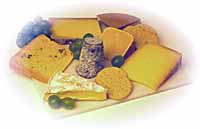
The
Kew Cheese Selection
To celebrate the opening of The Kew Cheese, an offer of fine
cheeses from Britain and Europe :
Bishop Kennedy (Scotland); Llanboidy (Wales); Shropshire
Blue (England); Chabichou de Poitou (France); Pecorino Toscano
(Italy); Gruyere Reserve (Switzerland); Scottish oatcakes and
a packet of Original Oval Alberts.
Minimum weight of cheese 1Kg.
Only
£26.95
including delivery
(to UK addresses only)
OFFER NOW OVER

We will include a free! corkscrew (made from the gnarled
branches of old French vines) with every order.
|
|
Welcome
to Ed Williams
Head Cheesemonger
at The Kew Cheese
Graduating from Manchester in 1990
with an English degree, Ed started his culinary career
by training as a chef at Leith's school of Food and
Wine, going on to work there as a chef in the early
90s. In 1995 he decided to set up a business of his
own, providing catering services for a wide variety
of clients, including The Tate Gallery and CNN. In
the middle of last year, he fell under the spell of
the cheese world, and was introduced to Tony and Doug
at the Teddington Cheese. Since then, as Assistant
Manager, he has readily embraced the world of the
cheesemonger giving him the ideal preparation for
his new role in the Kew Cheese.
|
 |
"Those that are passionate
about cheese enjoy coming in and tasting new cheeses every
week and will want to talk to us about the makers and enjoy
learning as much as eating".
"Children also tend to
find cheese fascinating and on first entering the store
will usually be very wide eyed with their noses screwed
up. In The Teddington Cheese, which has tiny proportions,
we would allow them to sneak into the back to visit the
cheese maturing room as a special treat. With more space
available in The Kew Cheese, we decided to build in a viewing
area so that the children can goggle to their hearts' content
at all our big cheeses sitting quietly on the shelves going
about the serious business of maturing - it has a calming
effect on them too which is an added bonus for the parents
who can then go about the serious job of tasting and choosing
the cheeses they want to buy".
Ed Williams
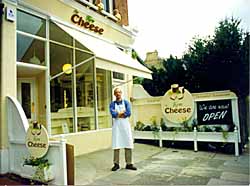 |
Ed
outside the new
Kew Cheese shop
Located
at:
The
Kew Cheese
277 Sandycombe Road Kew
Surrey
TW9 3LU
Tel: 0208 940 2944
|
|
|
|
Worldwide
Deliveries
Over the past few years, we have had numerous enquiries
about sending cheese abroad. Now that the internet site is gaining
more and more popularity, many people from across the globe are
showing interest. Some want to try farmhouse British and European
cheeses for the first time, whilst others are ex-pats who miss
the tastes of home. Whatever the reasons, we are pleased to announce
that our new Worldwide Delivery Service is now up and running,
so whether you want Tornegus sent to Toremolinos or Stilton to
San Francisco, we are now able to cater for your needs.
When shipping cheese abroad it is important to consider the type of
cheese. We have taken great care to ensure that our packaging methods
are as effective as possible at maintaining cheese in a good condition.
However, it is a sad fact that some cheeses travel better than others.
As a rule, hard or whole cheeses travel much better than soft, cut ones.
Although your penchant may be for soft, pungent Epoisses, there is yet
to be found a way of sending cut pieces half way across the globe, and
them arriving intact.
|
The
Taste of England cheese selection
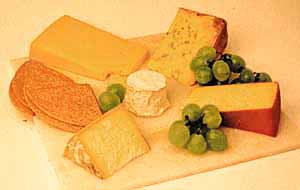
Fine
cheeses to celebrate our new Worldwide Service: Montgomery's
Cheddar, Colston Bassett Stilton, Ewes' milk Swaledale,
smoked Kirkhams Lancashire, a goats' milk Chabis and a packet
of oatcakes (800 grammes of cheese in total).
|
|
Yes please, add
to basket :
OFFER NOW OVER
Choose
zone according to countries listed in column on the right.
NB:
The cost in your shopping basket includes overseas delivery
minus the standard delivery cost of £5.95 which is
automatically added on when you go to checkout. (Work is
currently going on to include overseas delivery costs in
the shopping basket checkout calculator.)
| Zone
A |
£42.00
(£36.05 + standard del. of £5.95) |
|
| Zone
B |
£44.00
(£38.05
+ standard del. of £5.95)
|
|
| Zone
C |
£47.00
(£41.05
+ standard del. of £5.95) |
|
| Zone
D |
£45.00
(£39.05
+ standard del. of £5.95)
|
|
| Zone
E |
£49.00
(£43.05
+ standard del. of £5.95) |
|
|
Zone
F
|
£51.00
(£45.05
+ standard del. of £5.95) |
|
OFFER NOW OVER - please
look out for current offers on our home page
|
|
Worldwide
Delivery Charges
We
have arranged very competetive rates with DHL Worldwide Express
and our delivery costs directly reflect these rates. The first
kilogram of a consignment is the most expensive since it includes
the actual collection and delivery costs for the package. Additional
items can be added at a much lower rate because the only extra
cost is that of the aircraft fuel, since collection and delivery
costs have already been covered.
Zone A
Belgium,
Ireland, Luxembourg & Netherlands
£18.35
for the first kilogram and then £2.00 for each additional kilogram
Zone
B
France,
Germany & Monaco
£20.14
for the first kilogram and then £3.00 for each additional kilogram
Zone
C
Andorra,
Austria, Denmark, Finland, Greece, Italy, Portugal, Spain & Sweden
£23.64
for the first kilogram and then £4.20 for each additional kilogram
Zone
D
New
York City
£20.66
for the first kilogram and then £2.40 for each additional kilogram
Zone E - USA 1-2days £25.45 for the first kilogram and then £3.30
for each additional kilogram
Zone
F
Canada
2-3days, Canary Islands 2-3 days, Gibraltar, Norway & Switzerland
£27.04
for the first kilogram and then £3.40 for each additional kilogram
All
deliveries take 1 working day unless indicated otherwise. Please
contact us for prices and restrictions to other destinations.
back to top
| Caption
Competition Result |
 |
'It's not as messy as dunking biscuits
|
|
Thank
you to the winner Mr Ross of Newport and all the other
entrants who kept us chuckling.
|
|
|
|
Cheese
Focus Cheese
Focus Cheese Focus
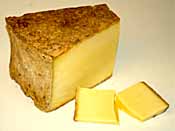 |
Beaufort
Savoie, France
|
Beaufort
is produced in the Savoie region on the massif Beaufortin, the
Tarentaise and the Maurienne. Cows are grazed during the summer
months at high altitude in areas free from pollution and fertilizers.
Some of the mountains reach 3000m with deep valleys in between.
Beaufort originally took its name from the little market town
near Albertville.
Beaufort is made from the milk of the Tarines
cow, a strong and hardy animal. This breed of cow originally came
from the Indo-Asian continent and crossed central Europe before
reaching France. During the winter months the cows are kept in
sheds to protect them from the heavy winter snow and, in accordance
with A.O.C. regulations, they are not fed any silage or other
fermented fodder. In spring they are taken high into the mountains
to graze on the lush grass and spring flowers of the alpine meadows.
In autumn they return to the villages before the winter snows.
The cows graze over the mountains for a 100 days from June to
September . The Beaufort is pale and white when made in the winter
and pale yellow when made in the summer. It is said that the chlorophyll
from the grass and the carotene from the alpine flowers gives
this cheese its colour and flavour.
The whey left over when making Beaufort is used
to make 'Sérac'. Sérac is a white cheese, similar
to ricotta. Its name derives from the Latin 'serum' meaning whey.
Together with Tomme, Sérac used to constitute the staple
diet of the mountain people, who kept their Beafort to sell at
market.
There are three types of Beaufort: Beaufort, Beaufort
d'été (summer) and Beaufort d'alpage (made in chalets
in the mountains). All Beaufort is made in a similar way to Gruyère
but can be easily distinguished by the concave shape around the
circumference produced by the 'cercle de Beaufort' - this is a
band placed around the cheese which is tightened during the first
pressing of the cheese. Beaufort does not have holes. The cheese
was baptised the 'Prince of Gruyères' by none other than
that great gastronome, Brillat-Savarin in the 19th Century and
it gained its A.O.C. status on 4th April 1968. This was modified
on 29th December 1986 to include a wider area of acceptable production.
Our Beaufort is made in the spring and summer
from unpasteurised milk and is matured from 12 to 18 months to
give a rich hazelnut aroma and very fruity flavour which lingers
in the mouth. Each cheese is matured at 15 degrees C, at a humidity
of 92% and is repeatedly wiped and rubbed with brine. Each cheese
measures from 35 to 75cm in diameter, 11 to 16cm in depth and
weighs from 20 to 70kg. Twelve litres of milk are needed for every
one kilogram of cheese.
Beaufort is often enjoyed with Volnay (Côtes
de Beaune) or a golden yellow wine of the Savagnin grape (from
the Savoie) matured in oak casks for at least six years giving
it a walnut flavour. The cheese is often added to fondues and
has earned its place in the best chefs' kitchens.
back to top
|
Tools
of the Trade
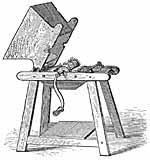
The
Curd Mill
Cutting
the curds is an important part of most cheese-making. When the
curd originally forms, it has a fibrous, matted structure, which
needs to be broken down to allow salting and the filling of the
moulds. The function of the curd mill is to tear apart the curds
into small pieces.
The
first description of a Curd Mill appeared in 1778. The machine
consisted of two rollers, which worked one above the other. The
top roller would break the curds up into chunks, allowing them
to fall on to the lower roller, which tore them into much smaller
pieces. Both rollers were moved by a crank, attached to the axle
of the upper roller.
Today,
most cheeses are made by cutting the curds using mechanical blades,
which slice, rather than tear, the curds. However, some traditional
manufacturers still prefer the old machines, maintaining that
the curds have a better quality when torn.
back to top
WORDSEARCH
| M |
U |
N |
S |
T |
E |
R |
B |
P |
|
|
| A |
R |
O |
O |
S |
B |
A |
R |
I |
L |
C |
| N |
D |
G |
A |
D |
R |
C |
A |
C |
A |
H |
| C |
A |
R |
S |
T |
I |
L |
T |
O |
N |
E |
| H |
G |
U |
B |
B |
E |
E |
N |
D |
G |
S |
| E |
|
Y |
|
F |
E |
T |
A |
O |
R |
H |
| G |
J |
E |
T |
O |
S |
T |
|
N |
E |
I |
| O |
U |
R |
D |
E |
R |
E |
|
|
S |
R |
| G |
I |
E |
N |
T |
O |
M |
E |
T |
T |
E |
| S |
A |
I |
N |
T |
M |
A |
R |
C |
E |
L |
Every letter in this wordsearch square is used to spell one or
more types of cheese (words run horizontally and vertically but
not diagonally). How many cheeses can you identify?
All entries must be received by 15th November '99 (please include your
name, address and telephone number). The winner will receive the Kew Cheese
selection.
COMPETITION NOW OVER
Please see issue 9 for details of the winner.
|
|
Tarte
Savoyarde au Beaufort
|
|
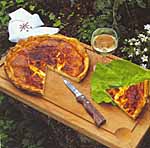
ingredients:
200g
flour
100g
butter
half a glass of water
150g
Beaufort (grated)
2 dessert spoons
of crème fraîche
2
eggs
600ml whole milk
1 sachet of yeast
nutmeg
salt and pepper to taste
|
Method:
1. Prepare the
shortcrust pastry by mixing the flour, butter, water and
a couple of good pinches of salt.
2. Lie the pastry in a pre-buttered flan dish, and prick
the surface with a fork.
3. In a bowl, beat the crème fraîche vigorously
with the eggs, milk and yeast. Season, then grate in some
nutmeg.
4. Add the grated Beaufort, beat well once again, and pour
the mixture onto the pastry.
5. Cook in a hot oven 220°C for 30 minutes.
6. Remove from the dish and serve hot.
serves 6-8
back to top
|
|
All articles © www.teddingtoncheese.co.uk
|